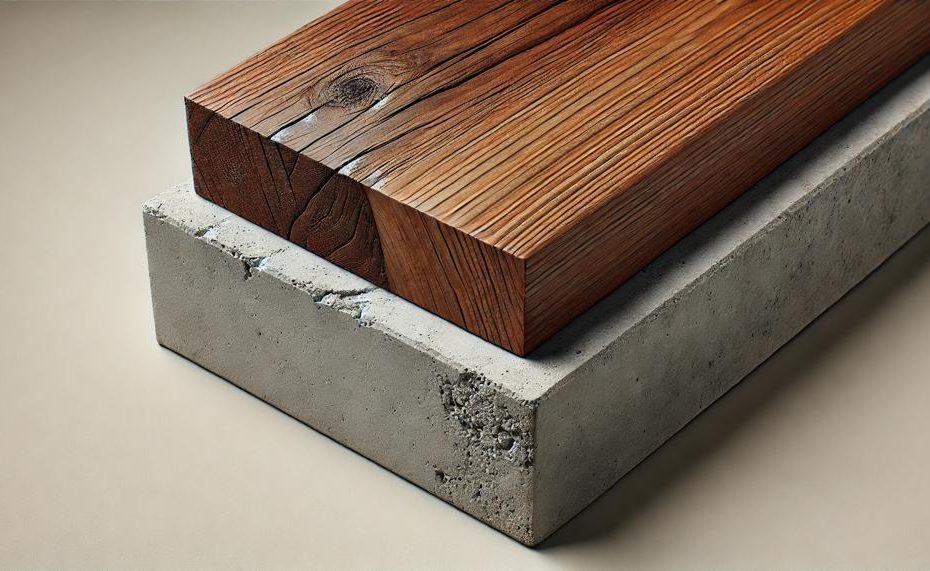Yes, solid wood can be glued to concrete, and it can be a practical solution for various construction and renovation projects. Whether you’re installing wood flooring over a concrete slab or attaching wooden fixtures to a concrete wall, the process is straightforward with the right materials and methods. Here’s a quick rundown of what you need to know:
- High-Quality Adhesive: Use adhesives like polyurethane-based, epoxy resin, or construction adhesive designed specifically for wood and concrete.
- Surface Preparation: Ensure both wood and concrete surfaces are clean, dry, and free from any debris, paint, or sealant.
- Priming: Apply a primer to both surfaces to enhance adhesion and bonding strength.
- Application Technique: Apply the adhesive evenly, press the surfaces together firmly, and use clamps or heavy objects to hold the wood in place as the adhesive sets.
This simple yet effective approach ensures a strong and lasting bond between wood and concrete, making your DIY or professional projects more durable and reliable.

Table of Contents [show]
What Exacly is glue wood to concrete?
The glue adheres wood to concrete through a chemical bond that forms between the adhesive and the surfaces of both materials. This bond relies on the properties of the glue, which must be strong, durable, and suitable for both wood and concrete.
The type of glue used for this purpose typically includes polyurethane construction adhesive or epoxy adhesive. These adhesives are known for their high bonding strength, water resistance, and ability to withstand various environmental conditions.
Types of Glue for Wood to Concrete:
- Polyurethane Construction Adhesive
- Strengths: Creates a robust, flexible bond; waterproof; suitable for indoor and outdoor use.
- Application: Easy to use; no mixing required; can bond various materials.
- Epoxy Adhesive
- Strengths: Extremely strong and durable; excellent for heavy-duty applications.
- Application: Requires precise mixing of two components; more expensive; ideal for structural repairs.
Application Process:
Surface Preparation:
- Clean the concrete surface thoroughly, removing any dust, debris, or oil.
- Ensure the wood is clean and dry. Sanding the wood can improve adhesion.
- Check for loose or uneven areas on the concrete and level them if necessary.
Applying the Glue:
- Follow the manufacturer’s instructions regarding temperature and humidity conditions.
- Apply a generous amount of adhesive to the wood or concrete surface.
- Press the wood firmly against the concrete to ensure full contact.
Curing Time:
- Secure the wood in place using clamps or heavy objects to maintain pressure while the glue cures.
- Curing time can range from 24 hours to several days, depending on the adhesive type.
Comparison Table:
| Adhesive Type | Strength | Application |
| Polyurethane Construction Adhesive | High, flexible | Easy to apply, no mixing required |
| Epoxy Adhesive | Extremely high, rigid | Requires mixing, precise application |
Why should you glue wood to concrete?
Using glue to adhere solid wood to concrete offers numerous benefits, enhancing the functionality and durability of various projects. Here’s a detailed look at these advantages:
| Benefit | Description |
| Strong Bond | Ensures the wood adheres firmly to the concrete, crucial for structural integrity. |
| Durability | Offers resistance to environmental factors, reducing the need for frequent repairs. |
| Versatility | Bonds well with different types of wood and concrete surfaces, suitable for various applications. |
| Gap Filling | Suitable for uneven surfaces, ensuring a secure attachment. |
| Ease of Application | Simple to apply without the need for complex tools, saving time and effort. |
| Aesthetic Appeal | Provides a seamless, clean look without visible nails or screws. |
| Moisture Control | Helps prevent wood warping or damage in humid or damp environments. |
How To Glue Wood To Concrete Overview
Yes, wood can be successfully glued to concrete with the appropriate methods and materials.
Choosing the Right Adhesive
- Polyurethane Construction Adhesive: Known for its strong bonding properties and resistance to moisture and temperature changes.
- Epoxy Resin Adhesive: Provides a robust bond and is often used for heavier or structural applications.
Surface Preparation
- Cleaning: Ensure both the wood and concrete surfaces are free from dust, dirt, and debris.
- Priming: Apply a primer suitable for both wood and concrete to enhance adhesion. This step is particularly crucial for ensuring a strong bond.
Application Process
- Applying Adhesive: Spread a thin, even layer of adhesive on both the wood and concrete surfaces. Follow the manufacturer’s guidelines for the best results.
- Pressing and Clamping: Firmly press the wood onto the concrete. Use clamps or weights to maintain pressure and ensure the adhesive spreads uniformly.
- Curing Time: Allow the adhesive to cure as per the manufacturer’s instructions, which typically ranges from 24 hours to a few days, depending on the product and conditions.
How To Glue Wood To Concrete Comparison of Glues for Gluing Wood To Concrete
When gluing solid wood to concrete, selecting the right adhesive is crucial for ensuring a strong and durable bond. The following types of glue are considered the best for this task, each with unique characteristics regarding strength and durability:
- Polyurethane Glue (Construction Adhesive)
- Epoxy Glue
- Polyvinyl Acetate (PVA) Glue
- Contact Cement
| Type of Glue | Strength | Durability |
|---|---|---|
| Polyurethane Glue | High | Waterproof, withstands extreme temperatures, ideal for outdoor use |
| Epoxy Glue | Very High | Resistant to heavy loads, vibrations, water, and chemicals; suitable for indoor and outdoor use |
| Polyvinyl Acetate (PVA) Glue | Moderate | Water-based, dries clear, best for indoor projects |
| Contact Cement | High | Creates an instant bond, strong odor, requires good ventilation |
Equipment for Gluing Wood to Concrete
Successfully gluing wood to concrete involves a range of equipment that ensures a durable and lasting bond. Below is a detailed list of essential equipment:
| Equipment | Description | Purpose |
| Epoxy-Based Adhesive | Two-component adhesive known for its strong bonding capabilities. | Creates a robust bond between wood and concrete, ideal for heavy-duty applications. |
| Polyurethane Adhesive | Durable adhesive with excellent resistance to water and chemicals. | Ensures longevity and durability of the bond, especially in moist environments. |
| Cyanoacrylate Adhesive (Super Glue) | Quick-bonding adhesive suitable for small projects. | Provides a fast and strong bond for minor applications or repairs. |
| Adhesive Applicator | Tools like trowels, brushes, or adhesive guns. | Enables precise application of adhesive for even coverage. |
| Sandpaper or Wire Brush | Abrasive materials used to clean and roughen surfaces. | Prepares wood and concrete surfaces for better adhesive bonding. |
| Clamps or Weights | Tools to hold materials in place while adhesive cures. | Ensures firm contact between wood and concrete during bonding. |
| Protective Gear | Items like gloves, masks, and goggles. | Ensures safety during adhesive application and handling. |
| Moisture Meter | Device to measure moisture levels in wood and concrete. | Checks suitability of surfaces before applying adhesive. |
| Sealant (Optional) | Substance applied to concrete before adhesive. | Prepares porous surfaces and improves bonding strength. |
Using the correct equipment is essential for a successful wood-to-concrete bonding project. For instance, epoxy and polyurethane adhesives are robust options for heavy-duty applications, while super glue works well for quick fixes.
Proper surface preparation with sandpaper or wire brushes ensures maximum adhesive effectiveness. Additionally, applying even pressure with clamps or weights during curing guarantees a solid bond.
Step by Step Instruction on How to Glue Wood to Concrete
To securely and effectively glue wood to concrete, follow these detailed steps:
| Step | Description | Additional Tips |
| Prepare the surfaces | Clean the concrete surface thoroughly using water and detergent to remove dirt and debris. Scrape or sand any rough areas on the concrete. Sand the wood surface to remove imperfections and create a rough texture for better adhesion. | Use a wire brush for stubborn dirt on the concrete. Ensure the wood is free from any finishes or coatings. |
| Apply a bonding agent | Apply a bonding agent or primer designed for wood and concrete. This creates a chemical bond between the surfaces, enhancing the adhesive strength. | Use a brush or roller for even application. Allow it to dry completely before proceeding. |
| Choose the right adhesive | Select a suitable adhesive like construction adhesive, epoxy glue, or polyurethane glue. Each offers strong bonding and different benefits such as moisture and temperature resistance. | For indoor projects, construction adhesive is often sufficient. Use epoxy for extreme conditions, and polyurethane for outdoor projects. |
| Apply the adhesive | Following the adhesive’s instructions, apply a generous amount to both the wood and concrete surfaces. Spread it evenly with a putty knife or notched trowel to create ridges for better adhesion. | Ensure full coverage without gaps to prevent weak spots in the bond. |
| Attach the wood to the concrete | Carefully place the wood onto the concrete, ensuring proper alignment. Use clamps or weights to hold it in place while the adhesive cures. | Leave the assembly undisturbed for at least 24 hours for optimal curing. |
| Finishing touches | Once the adhesive has dried, remove any excess glue with a scraper or sandpaper. Fill gaps or imperfections with wood filler for a seamless finish. | Consider painting or sealing the wood for added protection and aesthetic appeal. |
Conclusion
Solid wood can indeed be securely attached to concrete, opening up a wealth of possibilities for both construction and renovation projects. By utilizing the right adhesives and following proper techniques, you can achieve a robust and lasting bond. The key lies in selecting high-quality adhesives such as polyurethane-based or epoxy resin, which are specifically designed for bonding wood to concrete. These adhesives offer remarkable strength and durability, ensuring that your wooden fixtures or flooring remain firmly in place.
Preparation is crucial. Clean both surfaces meticulously, ensuring they are free of debris, paint, or sealant. Applying a primer enhances adhesion, making the bond even stronger. The application process itself is straightforward: spread the adhesive evenly, press the wood firmly against the concrete, and use clamps or heavy objects to maintain pressure while the adhesive sets. This careful approach ensures a durable bond, capable of withstanding various environmental conditions.
Using polyurethane construction adhesive is ideal for most indoor and outdoor applications due to its flexibility and waterproof nature. For heavy-duty tasks, epoxy adhesive offers unparalleled strength but requires precise mixing and application.






